NEET Biology Mcq Chapter Wise Ecological Pyramids
Question 1. The graphic representation of the inter-relationship between plants and animals is
- Ecological Niche
- Ecological Pyramid
- A trophic level
- None of the above
Answer: 2. Ecological Pyramid
Ecological pyramid represents the trophic structure and trophic function of an ecosystem. An ecological pyramid is a graphic representation of an ecological parameter like number of individuals, amount of biomass and amount of energy.
Question 2. Ecological pyramids were first devised by
- Charles Elton
- R Hesse
- RA Lindemann
- Justus van Liebig
Answer: 1. Charles Elton
“questions for ecology “
Ecological pyramids were first developed by Charles Elton (1927) and are therefore, also called Eltonian pyramids.
Read And Learn More: NEET Biology Multiple Choice Question And Answers
Question 3. Ecological pyramid are of
- Two Types
- Three Types
- Four Types
- Five types
Answer: 2. Three Types
Three types of ecological pyramids are pyramid of number, pyramid of biomass and pyramid of energy.
Question 4. Which of the following always has a pyramidal shape, that is decreasing values at higher trophic levels?
- Pyramids of number
- Pyramid of biomass
- Pyramids of energy
- All of the above
Answer: 3. Pyramids of energy
The pyramid of energy is always upright whatever will be the case. Thus, it always has a pyramidal shape, that is decreasing values at higher trophic levels.
Question 5. Which is an example of true pyramid in an ecosystem?
- Pyramid of biomass DUMET
- Pyramid of number
- Pyramid of energy
- None of the above
Answer: 3. Pyramid of energy
The pyramid of energy is always upright because energy is always lost as heat at each step. It represents the total amount of energy utilised by different trophic level organisms in unit area over a period of time. Hence, it is an example of true pyramid.

Question 6. Which of the following is not used for the construction of ecological pyramids?
- Number of individuals
- Fresh weight
- Rate of energy flow
- Dry weight
Answer: 2. Fresh weight
Fresh weight is not used for the construction of ecological pyramids. Even in pyramid of biomass, total dry weight of living matter is considered.
Mcq On Ecological Pyramids
Question 7. Topmost members of most of Eltonian pyramids are
- Producers
- Decomposers
- Carnivores
- Herbivores
Answer: 3. Carnivores
Topmost members of most of Eltonian pyramids are carnivores.
“ecology questions “
Question 8. In the pyramid of food, the primary producers lie at
- Base
- Apex
- Near The Position Of Base
- Near the position of apex
Answer: 1. Base
The pyramid of food contains primary producers at the base of the pyramid which traps the solar energy and converts it into the usable form of energy. These are followed by the herbivores and then to the carnivores at the top of the pyramid.
Question 9. The base of an ecological pyramid always represents the … A …, while the apex represents … B….
- A–producers, B–top level consumers
- A–top level consumers, B–producers
- A–producers, B–secondary consumers
- A–producers, B–primary consumers
Answer: 1. A–producers, B–top level consumers
Read And Learn More: NEET Biology Multiple Choice Question And Answers
Question 10. Consider the following statements about ecological pyramids.
- Charles Elton developed the concept of an ecological pyramid.
- It is a numerical representation or pyramid-shaped diagram which depicts the number of organisms, biomass and energy at each trophic level.
Choose the correct option.
- Statement 1 is correct, but 2 is incorrect
- Statement 1 is incorrect, but 2 is correct
- Both statements 1 and 2 are correct
- Both statements 1 and 2 are incorrect
Answer: 1. Statement 1 is correct, but 2 is incorrect
Statement I is correct, but 2 is incorrect. Incorrect statement can be corrected as Ecological pyramids diagrammatically represents the relationship between the number, biomass and energy contents of the producers and consumers of different trophic levels in any ecosystem.
Mcq On Ecological Pyramids
Question 11. Peacock eats a snake, snake eats frog and frog eats insects, while insects eat green plants. The position of peacock is
- Primary Producer
- Secondary Producer
- Decomposer
- At the apex of food ecological pyramid
Answer: 4. At the apex of food ecological pyramid
Green plants → Insects → Frog → Snakes → Peacock. From the above food chain, it is clear that the peacock stands at the apex.
“ecosystems questions and answers “
Question 12. Pyramid of number depicts
- Number Of Individual In The Subsequent Trophic Level
- Number Of Individual At A Place In Trophic Level
- Number Of Species Of Organisms At A Particular Trophic Level
- All of the above
Answer: 1. Number Of Individual In The Subsequent Trophic Level
Pyramid of number depicts the number of individual (organisms) at different (subsequent) trophic levels of food chain.
Question 13. In a pyramid of numbers, representing an ecosystem of a large freshwater pond, the number of primary consumers is DPMT
- More Than The Producers
- Less Than The Tertiary Consumers
- Less Than The Secondary Consumers
- More than the secondary consumers
Answer: 4.More than the secondary consumers
In the pond ecosystem, number of phytoplankton (producers) is larger than zooplanktons (primary consumers) and the latter are more in number than the secondary consumers.
Question 14. Which of the following can be observed in a pyramid of number in grassland ecosystem?
- Large number of producers at the bottom and fewer top consumers
- Large number of top consumers and fewer producers
- Equal number of producers and consumers
- Top consumer than primary consumers
Answer: 1. Large number of producers at the bottom and fewer top consumers
In a grassland ecosystem, the number of producers is more than the number of top carnivores, whereas in case of a tree, the number of producers is less as compared to consumers.
Mcq On Ecological Pyramids
Question 15. Assertion The pyramid of number of pond ecosystem is upright. Reason (R) Phytoplanktons are maximum and secondary consumers are least in number.
- Both A and R are true and R is the correct explanation of A
- Both A and R are true, but R is not the correct explanation of A
- A is true, but R is false
- Both A and R are false
Answer: 1. Both A and R are true and R is the correct explanation of A
Both A and R are true and R is the correct explanation of A. The pyramid of number in pond ecosystem is upright because base of this pyramid is occupied by the maximum number of phytoplanktons (autotrophs) and number of individuals gradually decreases towards the primary and secondary consumers side, respectively.
“questions about ecosystem with answers “
Question 16. The pyramid of numbers in grassland ecosystems is
- Linear
- Upright
- Inverted
- Negative
Answer: 2. Upright
The pyramid of numbers depicts the number of individual organisms at different trophic levels of the food chain. The pyramid of number in a grassland is upright as the producers are always maximum in number than herbivores and carnivores.
Question 17. In a tree ecosystem, the pyramid of numbers is
- Upright
- Inverted
- Both and
- None of these
Answer: 4. None of these
In a tree ecosystem, the pyramid of numbers is spindle-shaped. Here, the number of primary consumers is more than producers as well as top consumers. Tree → Several insects → Birds Thus, option is correct.
Question 18. The upright pyramid of numbers is absent in
- Pond
- Forest
- Lake
- Grassland
Answer: 2. Forest
Pyramid of number is always upright in grassland, pond and lake ecosystems. But in forest or single tree ecosystem, it is spindle-shaped and if parasitic food chain is considered, then it will be an inverted pyramid. Thus, the upright pyramid of numbers is absent in forest.
Question 19. Eltonian pyramids of numbers are upright in which of the following ecosystems?
- Grassland
- Tree
- Pond
- Both 1 and 3
Answer: 4. Both 1 and 3
Pyramid of numbers is always upright in grassland, pond and lake ecosystems. But in forest or single tree ecosystem, it is spindle-shaped and if parasitic food chain is considered, then it will be an inverted pyramid. Thus, the upright pyramid of numbers is absent in forest.
“ecosystem question answer “
Question 20. Which of the following pyramid of numbers in ecology is not upright?
- Pond ecosystem
- Desert ecosystem
- Tree ecosystem
- Forest ecosystem
Answer: 3. Tree ecosystem
Pyramid of number is always upright in grassland, pond and lake ecosystems. But in forest or single tree ecosystem, it is spindle-shaped and if parasitic food chain is considered, then it will be an inverted pyramid. Thus, the upright pyramid of number is absent in forest.
Question 21. The pyramid of number involving parasites in a tree ecosystem is
- Always Inverted
- Always Upright
- Mixture Of Inverted And Upright
- Sometimes Inverted And Sometimes Upright
Answer: 1. Always Inverted
The pyramid of numbers deals with the number of primary producers and consumers. It is inverted in a tree ecosystem involving parasites. In a tree, the number of producers (tree) is less as compared to consumers (parasites).
Question 22. Which of the following representations shows the pyramid of numbers in a forest ecosystem?
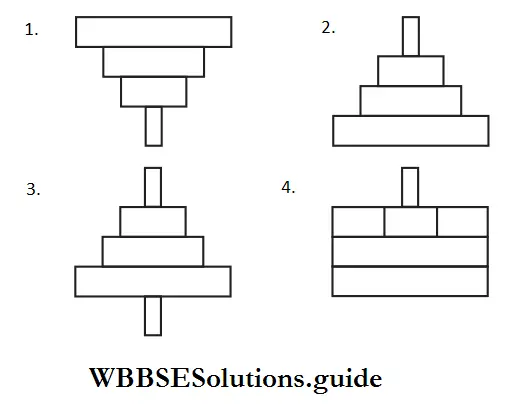
Answer: 3 is the correct option
In a tree ecosystem or forest ecosystem, the pyramid of numbers is spindle-shaped. Thus, option 3 is correct.
Question 23. Identify the pyramid of numbers in a grassland ecosystem from the following images.
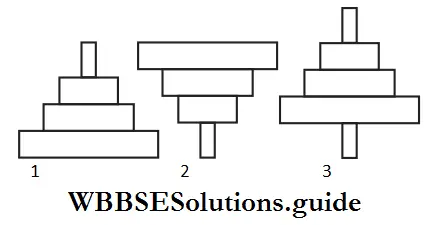
- 2
- 3
- 1
- Both 1 and 3
Answer: 3. 1
“anthropogenic ecosystem “
In a grassland ecosystem, a larger number of grass plants or herbs support a fewer number of grasshoppers that support a still smaller number of frogs, the latter still smaller number of snakes, and the snakes have very few peacocks or falcons
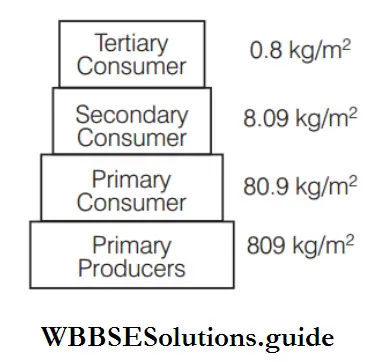
So, image A shows pyramid of numbers in a grassland ecosystem.
Question 24. Given below is an imaginary pyramid of numbers. What could be one of the possibilities about certain organisms at some of the different levels?
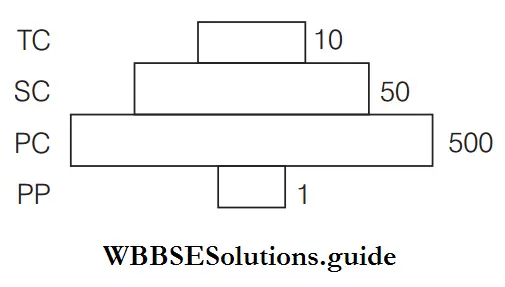
- Level PC is ‘insects’ and level SC is ‘small insectivorous birds’
- Level PP is ‘phytoplanktons’ in sea and ‘whale’ on top level TC
- Level one PP is ‘pipal trees’ and the level SC is ‘sheep’
- Level PC is ‘rats’ and level SC is ‘cats’
Answer: 1. Level PC is ‘insects’ and level SC is ‘small insectivorous birds’
The given figure shows spindleshaped pyramid of number in single tree ecosystem. Here, a single, large sized tree (PP) provides food to a large number of herbivores, insects (PC) which in turn support a few small insectivorous birds (SC) and the latter are eaten up by small number of top carnivores (TC).
Question 25. An ecological pyramid of biomass is the representation of the ecosystem’s AIIMS
- Energy Flow Through Each Trophic Level
- Population In Each Food Web
- Tissue Organisation At Each Trophic Level
- All of the above
Answer: 3. Tissue Organisation At Each Trophic Level
The amount of living or organic matter present in an organism is called biomass. It is measured as dry weight. It can also be referred to as tissue mass organisation at each trophic level. Maximum biomass occurs in producers. There is a progressive reduction of biomass at each trophic level.
“pond ecosystem pyramid “
Question 26. Given below is one of the type of ecological pyramids.
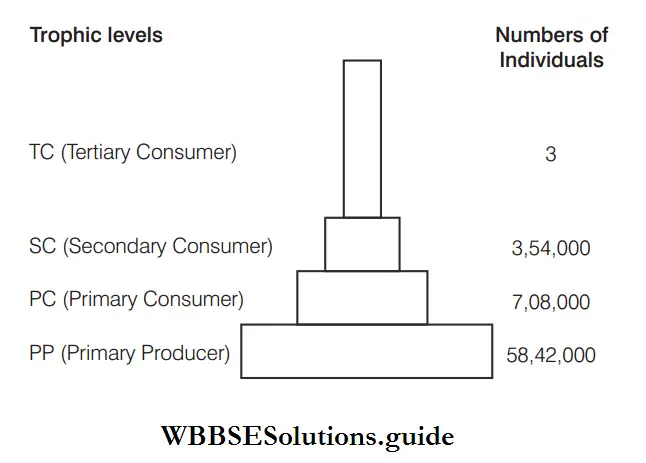
This type represents
- Pyramid Of Energy In A Grassland
- Pyramid Of Biomass
- Pyramid Of Number In A Lake
- Pyramid of nutrition
Answer: 2. Pyramid Of Biomass
The given ecological pyramid is pyramid of biomass representing dry weight of organisms at different trophic levels
NEET Biology Mcq Chapter Wise
Question 27. In a food chain, the total amount of living material is depicted by Manipal, BHU
- Pyramid Of Energy
- Pyramid Of Biomass
- Pyramid Of Numbers
- All of the above
Answer: 2. Pyramid Of Biomass
Pyramid of biomass is a diagrammatic representation of the amount of organic material or total amount of living material found in a particular habitat at ascending level ofthe food chain. A pyramid of biomass is a more accurate representation of the flow of energy through a food chain than pyramid of number, but seasonal variations may change the values for the amount of biomass.
Question 28. Assertion The pyramid of biomass indicates the decrease in biomass at each trophic level from base to apex. Reason (R) Parasites have inverted pyramid for biomass.
- Both A and R are true and R is the correct explanation of A
- Both A and R are true, but R is not the correct explanation of A
- A is true, but R is false
- Both A and R are false
Answer: 3. A is true, but R is false
A is true, but R is false. Reason can be corrected as Pyramid of biomass in case of parasites cannot be inverted because the amount of biomass produced by parasites is very small as compared to the host organism.
Question 29. In an upright pyramid of biomass, the herbivores occupy the position
- 4
- 2
- 3
- 1
Answer: 2. 2
Herbivores are organisms that feed upon plants only. In an upright pyramid of biomass, as plants (producers) always form first trophic level, herbivores occupy the second position.
NEET Biology Mcq Chapter Wise
Question 30. The biomass pyramid of forest is
- Inverted
- Upright
- Infinite
- Finite
Answer: 2. Upright
The biomass of producers is greater than the biomass of top consumers in the forest ecosystem. Thus, the pyramid of biomass in forest is upright.
Question 31. The greatest biomass of autotrophs in the oceans is that of
- Sea Grasses And Slime Moulds
- Free-Floating Microalgae, Cyanobacteria And Nanoplankton
- Benthic Brown Algae, Coastal Red Algae And Daphnids
- Benthic diatoms and marine viruses
Answer: 2. Free-Floating Microalgae, Cyanobacteria And Nanoplankton
The greatest biomass of autotrophs in the oceans is that of free-floating microalgae, cyanobacteria and nanoplankton.
Question 32. In a lake ecosystem, the pyramid of biomass is
- Upright
- Inverted
- Anything is possible
- None of the above
Answer: 2. Inverted
In pond or lake ecosystem, pyramid of biomass is of inverted type as biomass of producers (small plants) is less and of consumers (fishes) is more.
Question 33. Inverted pyramid of biomass can be traced in one of the following ecosystems.
- Rainforest
- Desert
- Ocean
- Tundra
Answer: 3. Ocean
In ocean ecosystem, producers are the smallest organisms, while carnivores are large in size. Consequently, there is a gradual increase in biomass of organisms at successive trophic levels from producers to top carnivores, resulting in inverted pyramid.
NEET Biology Mcq
Question 34. In a pyramid of biomass, if the total dry weight (kg/m²) of primary producers is about 809, it will decrease at tertiary consumer level up to
- 37 kg/m²
- 11 kg/m²
- 5 kg/m
- 1.5 kg/m²
Answer: 4. 1.5 kg/m²
If in a pyramid of biomass, total dry weight (kg/m²) of primary producers is about 809, it will decrease at subsequent level, as only 10% is passed on to the next trophic level.
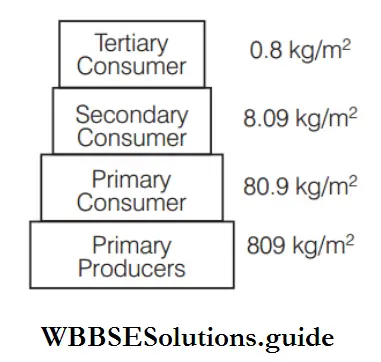
Thus, 0.8 kg/m² remains at tertiary consumers. But 1.5 kg/m² is the nearest value given in options. Thus, option is correct.
Question 35. Which is the reason for highest biomass in aquatic ecosystem?
- Nanoplankton, blue-green algae, green algae
- Sea grass and slime moulds
- Benthic and brown algae
- Diatoms
Answer: 3. Benthic and brown algae
Highest biomass in aquatic enviroment is contributed by benthic and brown algae. The benthic region includes all the sea floor. Due to abundance of light, oxygen, CO2 and less salinity, this zone support dense growth of biomass production.
NEET Biology Mcq
Question 36. What type of ecological pyramid would be obtained with the following data?
Secondary consumer: 120 g
Primary consumer: 60 g
Primary producer: 10 g
- The inverted pyramid of biomass
- Upright pyramid of biomass
- Upright pyramid of numbers
- Pyramid of energy
Answer: 1. Inverted pyramid of biomass
The given data depicts the inverted pyramid of biomass, because the biomass is increasing from producers to consumer level. It is usually found in aquatic ecosystem.
Question 37. Consider the following statements pertaining to pyramid of biomass.
- A plot of the net dry weight of producers, herbivores and carnivores gives us a pyramid of biomass.
- Pyramids of biomass can be upright or inverted.
- An upright pyramid is obtained when organisms with larger biomass support organisms with smaller biomass.
- When smaller weight of producers support larger weight of consumers, an inverted pyramid of biomass is formed.
Choose the option containing correct statements.
- 2 and 3
- 1 and 4
- 3 and 4
- 1, 2, 3 and 4
Answer: 4. 1, 2, 3 and 4
All given statements are correct.
Question 38. The pyramid of biomass and the pyramid of number represent
- The Rate Of Energy Flow
- The Rate Of Food Production
- Standing Crop
- Relationship Among Organisms
Answer: 4. Relationship Among Organisms
An ecological pyramid (pyramid of numbers, pyramid of biomass, pyramid of energy) is a graphical representation of the relationship between different organisms in an ecosystem.
Question 39. An inverted pyramid of number and an inverted pyramid of biomass are, respectively seen in
- Grassland And Tree Ecosystem
- Sea And Tree Ecosystem
- Tree And Sea Ecosystem
- Sea And Grassland Ecosystem
- Tree and grassland ecosystem
Answer: 3. Tree And Sea Ecosystem
In a tree ecosystem, the number of insects feeding on a single tree is very large. But, the number of small birds eating these insects and large birds eating small birds successively reduces. Hence, a spindle-shaped or inverted pyramid of number is obtained. Also pyramid of biomass in sea is generally inverted because the biomass of fishes far exceeds that of phytoplanktons.
Biology MCQ For NEET With Answers
Question 40. The efficiency of any ecosystem is best depicted by pyramid of
- Energy
- Number
- Biomass
- Volume
Answer: 1. Energy
The pyramid of energy is the most efficient in describing the ecosystem.
Question 41. Pyramid of energy is always
- Inverted
- Upright
- Spindle-shaped
- None of these
Answer: 2. Upright
The pyramid of energy for any ecosystem (desert, forest, river, pond, etc.) is always upright, because energy is transferred from herbivores to carnivores and finally to the top carnivores. With every transfer, a certain amount of energy is lost in form of heat or radiation. Thus, in all ecosystems, the energy value decreases and finally it is completely used up by the top carnivores.
Question 42. Given below is the diagram of the ecological pyramids.
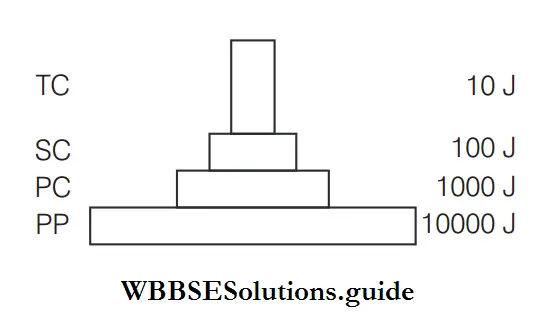
This type represents
- Pyramid Of Number In A Grassland
- Pyramid Of Biomass In A Lake
- Pyramid Of Biomass In A Land
- Pyramid of energy
Answer: 4. Pyramid of energy
The given pyramid represents pyramid of energy.
Question 43. Calculate the rate of secondary production in the energy pyramid given below?
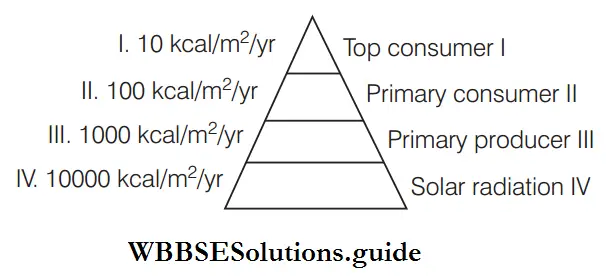
- Uncertain
- 100 kcal/m²/yr
- 10 kcal/ m²/yr
- 110 kcal/m²/yr
Answer: 3. 10 kcal/ m²/yr
Plant utilise only 1-2% of total energy incident on earth. In the given question, 10000 kcal/m²/yr solar radiation is incident on earth. So, plant producers utilise 1 % of 10000 kcal/m²/yr
Question 44. The pyramid of energy is the best representation of an ecosystem because it indicates
- Relation Of All Plants And Animals
- Total Energy Present In An Ecosystem
- The rate of energy flow through the food chain
- None of the above
Answer: 3. The rate of energy flow through the food chain
Pyramids of energy are the most fundamental and they indicate the overall nature of the ecosystem. It is a graphical representation of amount of energy trapped per unit time and area in different trophic levels of a food chain, i.e. it indicates the rate of energy flow through the food chain.
Question 45. Pyramid of energy is always upright, it represents
- There Is an Increase In the Energy Of the Ecosystem
- There Is a Decrease In Energy Due To Concentration In Successive Levels
- There Is a Decrease In Energy Due To Loss In The Form Of Heat In Each Trophic Level
- There is an increase in energy due to gain of heat in each trophic level
Answer: 3. There Is a Decrease In Energy Due To Loss In The Form Of Heat In Each Trophic Level
The pyramid of energy for any ecosystem (desert, forest, river, pond, etc.) is always upright because energy is transferred from herbivores to carnivores and finally to the top carnivores. With every transfer, a certain amount of energy is lost in the form of heat or radiation. Thus, in all ecosystems, the energy value decreases and finally, it is completely used up by the top carnivores.
Biology MCQ For NEET With Answers
Question 46. The pyramid of energy is always upright for any ecosystem. This situation indicates the fact that
- Producers Have The Lowest Energy Conversion Efficiency
- Carnivores Have A Better Energy Conversion Efficiency Than Herbivores
- Energy Conversion Efficiency Is The Same In All Trophic
- Herbivores Have A Better Energy Conversion Efficiency Than Carnivores
Answer: 4. Herbivores Have A Better Energy Conversion Efficiency Than Carnivores
The pyramid of energy is always upright for any ecosystem. This situation indicates the fact that herbivores have a better energy conversion efficiency than carnivores.
Question 47. Assertion The pyramid of energy is always upright. Reason (R) Number of autotrophs in the pyramid of energy is maximum.
- Both A and R are true and R is the correct explanation of A
- Both A and R are true, but R is not the correct explanation of A
- A is true, but R is false
- Both A and R are false
Answer: 3. A is true, but R is false
A is true, but R is false. The reason can be corrected as the Number of autotrophs in the pyramid of energy is not represented. It represents the energy, in Joules, present in the autotrophs.
Question 48. Which one of the following statements for the pyramid of energy is incorrect?
- Its base is broad
- It shows the energy content of different trophic-level organisms
- It is inverted in shape
- It is upright in shape
Answer: 3. It is inverted in shape
Statement in option is incorrect and can be corrected as Pyramid of energy is always upright and can never be inverted. Rest statements are correct for the pyramid of energy.
Question 49. Identify the incorrect statement from the following.
- Pyramid of biomass in sea is generally inverted as the biomass of fish far exceeds that of phytoplanktons
- Pyramid of energy is mostly upright, but sometimes it may be inverted
- Food chains are generally short with few trophic levels as only 10% of the energy is transferred to each trophic level from the lower trophic level
- Pyramids of number and biomass may be either upright or inverted
Answer: 2. Pyramid of energy is mostly upright, but sometimes it may be inverted
Question 50. Which one of the following statements regarding the ecological pyramid is not correct?
- In most ecosystems, the pyramid of numbers and biomass are upright
- In tree dominated ecosystem, the pyramid of numbers is inverted
- The pyramid of energy expresses mainly the rate of food production
- In deep water ecosystem, the pyramid of biomass is upright
Answer: 4. In deep water ecosystem, the pyramid of biomass is upright
Statement in option is not correct and can be corrected as: In aquatic ecosystem, the producers are small organisms with least biomass and the biomass gradually increase towards the apex of the pyramid. Thus, the pyramid of biomass of aquatic ecosystem is inverted in shape. Rest other statements are correct regarding ecological pyramid.
Biology MCQ For NEET With Answers
Question 51. Identify the type of pyramid depicted below

- Pyramid of number in tree ecosystem
- Pyramid of biomass in tree ecosystem
- Pyramid of biomass in aquatic ecosystem
- Pyramid of energy in tree ecosystem
Answer: 3. Pyramid of biomass in aquatic ecosystem
In aquatic ecosystems, producers are the smallest organisms, while carnivores are large in size. Consequently, there is a gradual increase in the biomass of organisms at successive trophic levels from producers onward to top carnivores resulting in an inverted pyramid. In such an inverted pyramid of biomass in an aquatic ecosystem, a small standing crops of phytoplankton supports a large standing crop of zooplankton. Thus, the option 3 is correct.
Question 52. Given below is one of the types of ecological pyramids.
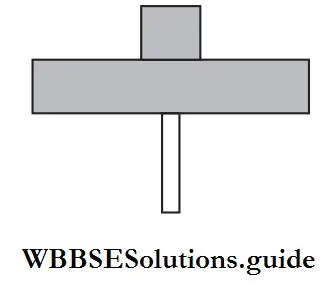
This type represents
- Pyramid Of Numbers In A Grassland
- Pyramid Of Biomass In A Fallow Land
- Pyramid Of Biomass In A Lake
- Energy pyramid in a spring
Answer: 3. Pyramid Of Biomass In A Lake
The given spindle-shaped pyramid is found in the lake ecosystem where the biomass of producers (phytoplanktons) and secondary consumers (fishes) is less than that of primary consumers (zooplanktons).
Question 53. Given below is one of the types of ecological pyramids.
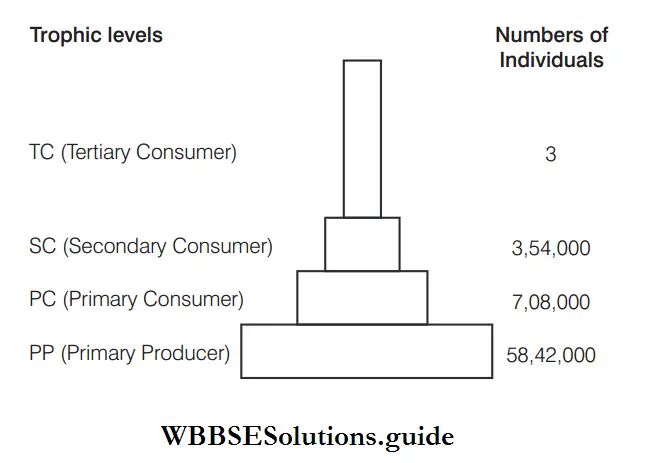
This type represents
- Pyramid Of Number In A Grassland Ecosystem
- Pyramid Of Energy In Forest Ecosystem
- Pyramid Of Biomass In Sea Ecosystem
- Pyramid Of Biomass In Terrestrial Ecosystem
Answer: 1. Pyramid Of Number In A Grassland Ecosystem
Question 54. Consider the following statements about limitations of ecological pyramid.
- It never takes into account the same species belonging to two or more trophic levels.
- It assumes a simple food chain, which never exists in nature.
- Eventhough a vital role is played by saprophytes decomposers, they do not hold any position in ecological pyramids.
Which of the statements given above are correct?
- Only 2
- Only 3
- 2 and 3
- 1, 2 and 3
Answer: 4. 1, 2 and 3
All given statements are correct.
